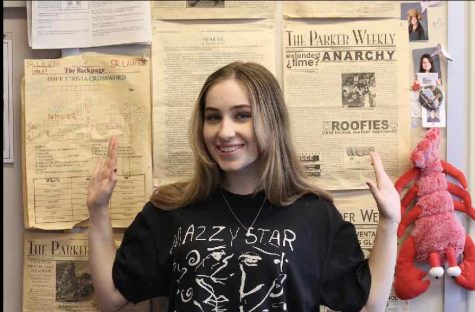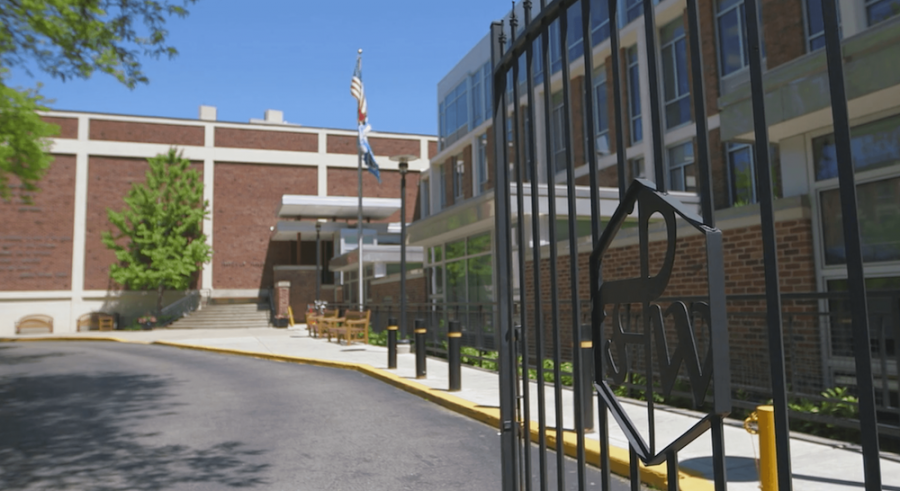Circling Back on History
Parker Renames Circle Drive after Jo Anderson
Photo credit: Francis W. Parker School
Parker’s “Circle Drive” on Clark Street pictured a few years ago. Photo courtesy of Francis Parker.
A familiar piece of pavement will now acknowledge and honor a key part of Parker’s history. In an email to the school community on November 24, Principal Dan Frank announced the renaming of Parker’s Circle Drive on Clark Street to “Jo Anderson Drive.”
Anderson, a Black man enslaved by Cyrus McCormick, made significant contributions to the transformative invention of the mechanical reaper. McCormick is often named as the sole inventor of the tool that revolutionized agriculture in 1840s America and generated Parker’s founding finances.
McCormick’s daughter, Anita McCormick Blaine, inherited a portion of her father’s fortune, which she used to help Colonel Francis W. Parker found the school. Blaine gave over $3 million to the school from 1901 to 1934, according to Parker’s website, money that subsidized 50% of the price of student education and funded faculty pensions in full.
Frank published an article detailing what he named as the institutional “ironies” of a school that calls itself progressive but is founded on wealth inherited from a slave owner and Confederate-sympathizer who profited off of the ingenuity of an enslaved Black man. In the Winter 2021 issue of “National Association of Independent Schools (NAIS) in Independent School Magazine,” Frank tells the story of Anderson in “A School’s Unacknowledged Past.”
He views the renaming as an educational moment, a way for Parker to acknowledge its connections to America’s past, present, and future, including white supremacy. “This is a man who made his contribution to the creation of the wealth that founded our school,” Frank said. “That does link our school to the horrible, ugly institution of chattel slavery.”
Many historians now credit Anderson for helping to prototype, refine, and design the mechanical reaper alongside McCormick, helping at the first public demonstration in 1831. A former curator at the family farm, Lester R. Godwin Jr., has said Anderson “has as much to do with the later development of the reaper as Cyrus McCormick.”
McCormick’s grandson, Cyrus McCormick III, credited Anderson for his contributions in his 1931 book “The Century of the Reaper,” writing that “Jo Anderson deserves honor as the man who worked beside [McCormick] in the building of the reaper.”
Nine people were enslaved by McCormick at his family farm in Virginia, inherited in 1846 after his father Robert’s death, according to a Princeton report. According to historical archives, McCormick remained loyal to the Confederacy even after he moved to Chicago and corresponded with Robert E. Lee after the Civil War.
McCormick is estimated to have earned $11 million from the reaper, over $250 million today by some estimates. The patent acts of 1793 and 1863 excluded enslaved inventors like Anderson from receiving credit for their work. Anderson was never given his share of the profits.
Frank first presented Anderson’s story to the Board of Trustees and faculty in Fall 2019 following the congressional hearings on reparations. Plans to publicize the story to the rest of the community were delayed by COVID-19 until this fall when the Board decided to honor Anderson.
Frank says his research was initially prompted by a conversation about colleges that were acknowledging their ties to institutional racism and slavery in America, renaming buildings that honored slaveowners. Former Seventh Grade Assistant Justin James posed to Frank that Parker may have connections of its own to slavery. “All my years at the school, never heard that story, never pushed the origins of the McCormicks,” Frank said.
In his article, Frank also emphasized the need to “look at the gap between our stated ideals and marketing profiles and the truths named by our current and former students of color.”
“We have been rightly challenged to be as enlightened and progressive as we say we are by our own students and alumni of color and their white allies and to include their stories in our portrayal of who we are as educational communities,” Frank wrote.
Frank is referencing @FWPAnonymous, an account formed by Parker alumni to chronicle stories from current and former community members about racism and oppression they experienced at the school. In a letter to the school organized by the heads of the account last summer, @FWPAanonymous asked that students were taught “Parker’s history as a progressive school that benefitted from oppression.”
“We have no idea how and when Parker integrated, when it first began hiring Black teachers, or anything else about the school’s history involving race and racism,” the letter said in Clause 2f. “Our lack of knowledge here is an institutional and educational failure on Parker’s part.”
“Those stories have been told,” Frank said, referring to the school’s history with race. “We can continue to find newer ways to do so. The facts are really important: what the school did, what it didn’t do, when it did it, how does that compare to other people.”
@FWPAnonymous also brought attention to the school’s current naming protocol in their letter to the school. “Rooms, art, and other spaces named after families must have their names changed, and we demand Parker discontinue the practice of naming a room or space after a family’s donation,” @FWPAnonymous said in clause 5dii.
Parker’s current building is named for Blaine and its alcove after the first principal, Flora J. Cooke, while many other spaces in the school are named after donors, such as the Heller Auditorium, the Kovler Family Library, the Sheridan Cafe, and the Harris Center.
Upper School English Teacher Teresa Collins asked her American Literature students to imagine a new name for Parker as their final project. “One of the things that’s come up in our class is – does a name ever really tell the full story and what responsibility do members of the community have to learn this story,” Collins said. “We see in Chicago honorary street names all the time, but because it’s on signs or because it’s on a plaque, there’s not a whole lot of room for the full story.”
“How many people are going to know the story of Jo Anderson because they’ve been members of the Parker community, and they know the story that Dr. Frank told about what he discovered,” Collins said, “and how many people, in time to come, are going to just look at it and not realize what it means?”
Frank said he wants to teach the story or incorporate it into the curriculum in the future. A plaque describing Anderson’s contribution to the school and his enslavement will be installed at the driveway, though the official naming ceremony has been delayed.
Frank said the Board discussed honoring Anderson in a space towards the front of the school. “Circle Drive became the focal point,” Board Member and Parker parent Valerie Chang said. “Its prominence for this school as an entry and egress point seems to be fitting.”
Collins pushed back. “There are other spaces on our campus that naturally encourage a person to pause and reflect,” Collins said. “Circle Drive is not one of those places. It’s a place where you zoom in and then you zoom out. It’s a thoroughfare and it’s a space that is meant to be traveled. It is not a space that is meant to be visited for any length of time.”
Collins hopes Anderson’s story is told and acknowledged on a sustained basis. “Just having the conversation, inclusive of the layers of stories, is pretty powerful and important as a first step,” Collins said. “From there I think it’s up to the people who inhabit the space after the renaming has occurred.”
Frank agreed. “It isn’t just, ‘Oh yeah, remember that one time back in 2021, there was a story that went around,’” Frank said. “How do we make this an ongoing understanding of who we are?”
Frank included a brief summary of Parker’s Diversity, Equity, and Inclusion work at the end of the NAIS article, framing Anderson Drive as one piece of the school’s work. “The symbol isn’t the answer,” Frank said. “It is part of the effort but it’s not the fullness of the effort by any means.”













Nancy Rinehart • Jul 31, 2022 at 4:07 PM
As a regular rider of the 36 Broadway bus, I actually noticed the Jo Anderson name on the circular drive during my daily commute and was curious. So I just looked up the story, which I’m so glad I did. Wanted you to know that while people do mostly “zoom in and zoom out” of the drive, there are people out there who do notice the signage!